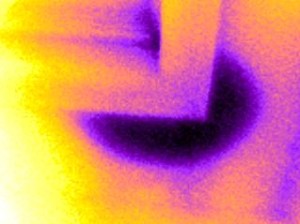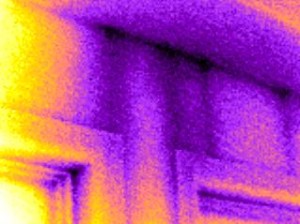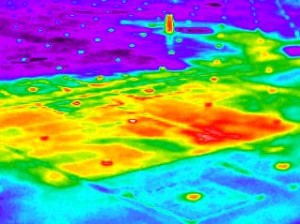Mold and Moisture Detection
According to the U.S. Environmental Protection Agency, there is no practical way to eliminate mold spores in an indoor environment. The best way to control mold growth is to control moisture. Mold can begin growth in as little as 24 hours. Roof leaks and water pipe leaks are common sources of water accumulation that may cause mold growth. Mold has closed public schools and caused companies to spend millions of dollars on environmental tests and remediation. Clearly, there is more reason to become aware of roof conditions, before water begins dripping on a building owner’s head.
 Moisture present in roofs and walls can be detected with a sensitive infrared camera, under the right conditions. Infrared roof inspections are performed most effectively after sunset, when the roof gives off its heat energy accumulated during the day. The heat capacity of moisture soaked roof insulation is greater than that of dry insulation. As a result, the moisture soaked roof areas appear quite clearly when performing an infrared scan
Moisture present in roofs and walls can be detected with a sensitive infrared camera, under the right conditions. Infrared roof inspections are performed most effectively after sunset, when the roof gives off its heat energy accumulated during the day. The heat capacity of moisture soaked roof insulation is greater than that of dry insulation. As a result, the moisture soaked roof areas appear quite clearly when performing an infrared scan Similarly, it is possible to detect moisture located behind interior walls with an infrared camera, under the right conditions. The temperature difference created by the presence of moisture on the inside surface of a wall will appear differently than the surrounding area.
Similarly, it is possible to detect moisture located behind interior walls with an infrared camera, under the right conditions. The temperature difference created by the presence of moisture on the inside surface of a wall will appear differently than the surrounding area.Infrared Solutions Inc. created the IR-InSight and FlexCam S portable infrared imagers specifically for this application. At the heart of the IR-InSight and FlexCam S is an extremely sensitive microbolometer thermal sensor that can distinguish between temperate differences of less than 1/20 degree F.

